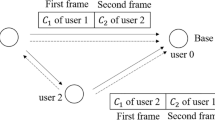Abstract
A Plotkin based polar coded orthogonal frequency division multiplexing (OFDM) with multiple input and multiple output (MIMO) antennas scheme is proposed and its performance over frequency selective Rayleigh fading channel has been evaluated. In the considered Plotkins construction, the longer length code word is formed on the basis of two shorter length code words. Due to the presence of a parallel split in the design of the considered Plotkins construction, the proposed scheme is efficiently extended to coded cooperative scenarios. As the relay always plays crucial role in the design of cooperative communication system, therefore an intelligent criteria for the selection of information bits is employed at the relay node. To check the efficacy and to maintain the complete fairness in the performance of the proposed coded cooperative scheme, the authors have also developed the traditional nested polar coded cooperative scheme in the context of OFDM with MIMO antennas. The Monte Carlo simulated bit error rate (BER) performance revealed that the proposed coded cooperative scheme outperforms the traditional nested polar coded cooperative OFDM with MIMO antennas scheme by gain of \(0.5 \;{\sim}\; 0.6\) dBs. This significant gain in BER performance of the proposed coded cooperative scheme is made possible due to the efficient selection criteria and the joint successive cancellation (SC) decoding tecnique employed at relay node and at the destination node, respectively. Moreover, the proposed coded cooperative scheme outperforms its corresponding coded non-cooperative counterpart scheme by roughly a gain of 1 dB under identical conditions.










Similar content being viewed by others
References
Sendonaris, A., Erkip, E., & Aazhang, B. (2003). User cooperation diversity. Part I. System description. IEEE Transactions on Communications, 51(11), 1927–1938.
Sendonaris, A., Erkip, E., & Aazhang, B. (2003). User cooperation diversity. Part II. System description. IEEE Transactions on Communications, 51(11), 1939–1948.
Su, W., Safar, Z., Olfat, M., et al. (2003). Obtaining full-diversity space–frequency codes from space–time codes via mapping. IEEE Transactions on Signal Processing, 51(11), 2906–2916.
Huo, P., & Cao, L. (2012). Distributed STBC with soft information relay based on Gaussian approximation. IEEE Signal Processing Letters, 19(10), 599–602.
Mheidat, H., Uysal, M., & Al-Dhahir, N. (2006). Distributed space–time block coded OFDM for relay-assisted transmission. In IEEE international conference on communications, ICC’06 (pp. 4513–4519).
Hunter, T. E., & Nosratinia, A. (2006). Diversity through coded cooperation. IEEE Transactions on Wireless Communications, 5(2), 283–289.
Mughal, S., Yang, F. F., Ejaz, S., et al. (2017). Asymmetric turbo code for coded-cooperative wireless communication based on matched interleaver with channel estimation and multi-receive antennas at the destination. Radioengineering, 26(3), 878–889.
Tang, L., Yang, F. F., Zhang, S., et al. (2013). Joint iterative decoding for LDPC-coded multi-relay cooperation with receive multi-antenna in the destination. IET Communications, 7(1), 1–12.
Ejaz, S., & Yang, F.-F. (2016). Jointly optimized reed-muller codes for multi-level multi-relay coded-cooperative VANETS. IEEE Transactions on Vehicular Technology, 66(5), 4017–4028.
Soliman, T., Yang, F.-F., & Ejaz, S. (2016). Decode and forward polar coding for half-duplex two-relay channels based on multilevel construction. International Journal of Electronics, 11(2), 185–191.
Lin, J. C., & Stefanov, A. (2005). Coded cooperation for OFDM systems. In Proceedings of IEEE wireless networks, communications and mobile computing (Vol. 1, pp. 7–10).
Arikan, E. (2009). Channel polarization: A method for constructing capacity-achieving codes for symmetric binary-input memoryless channels. IEEE Transactions on Information Theory, 55(7), 3051–3073.
Andersson, M., Rathi, V., Thobaben, R., et al. (2010). Nested polar codes for wiretap and relay channels. IEEE Communications Letters, 14(8), 752–754.
Blasco-Serrano, R., Thobaben, R., Andersson, M., et al. (2012). Polar codes for cooperative relaying. IEEE Transactions on Communications, 60(8), 3263–3273.
Bravo-Santos, A. (2013). Polar codes for Gaussian degraded relay channels. IEEE Communications Letters, 17(2), 365–368.
Plotkin, M. (1960). Binary codes with specified minimum distance. IRE Transactions on Information Theory, 6(4), 445–450.
Ejaz, S., Yang, F., & Xu, H. (2015). Jointly optimized multiple Reed–Muller codes for wireless half-duplex coded-cooperative network with joint decoding. EURASIP Journal on Wireless Communications and Networking, 14(8), 115–754.
Ejaz, S., Yang, F., & Soliman, T. H. (2015). Multi-level construction of polar codes for half -duplex wireless coded-cooperative networks. Frequenz, 69(12), 509–517.
Alamouti, S. M. (1998). A simple transmit diversity technique for wireless communications. IEEE Journal on Selected Areas in Communications, 16(8), 1451–1458.
Akoun, P., & Xu, H. (2014). Polar coded spatial modulation. IET Communications, 8(9), 1459–14686.
Van Der Meulen, E. C. (1971). Three-terminal communication channels. Advances in Applied Probability, 3, 120154.
Acknowledgements
This work is supported by National Natural Science Foundation of China under the Contract No. 61771241.
Author information
Authors and Affiliations
Corresponding author
Additional information
Publisher's Note
Springer Nature remains neutral with regard to jurisdictional claims in published maps and institutional affiliations.
Rights and permissions
About this article
Cite this article
Umar, R., Yang, F., Xu, H. et al. Distributed Polar Code Based on Plotkins Construction with MIMO Antennas in Frequency Selective Rayleigh Fading Channels. Wireless Pers Commun 104, 287–306 (2019). https://doi.org/10.1007/s11277-018-6020-y
Published:
Issue Date:
DOI: https://doi.org/10.1007/s11277-018-6020-y




